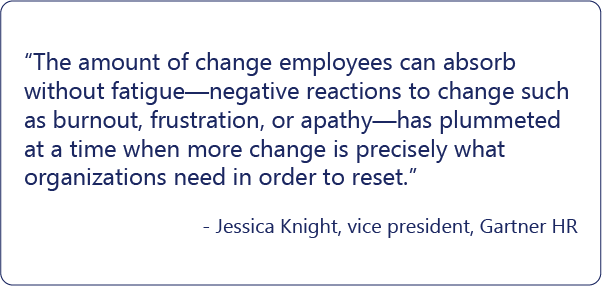5-minute read
Check out our updated predictions for change management trends in 2022.
We’ve always known that change is an inevitable part of business, but the events of 2020 would give even a change management ninja a bad case of heartburn. As businesses faced a global pandemic, social tensions, economic uncertainty, and political discord, sometimes it seemed that pivoting had become the new norm. As we examine the 2021 trends that will shape the change management landscape, one thing is certain: the disruptions of 2020 have made an indelible mark on how organizations will handle change going forward.
Need help with change management?
How 2020 impacted employees’ ability to absorb change
Gartner recently reported an alarming statistic: In the year 2020, the amount of change the average employee could absorb before fatiguing was cut in half compared to 2019. As employees coped with uncertainties concerning the economy, job security, the health of their families, and the nation’s political future, their capacity to deal effectively with change in the workplace has plummeted.
Faced with this reality, change managers must adapt their game plans. Regardless of what else is going on in the world, change will continue to occur on the organizational level, and the need for a strategic approach to change management has never been greater.

Trend 1: Optimizing digital communications
As COVID-driven health and safety measures instigated a large-scale workforce shift from the office to the home, nearly all work-related communications transitioned to digital formats. Over a period of days, in-person interactions, from water-cooler chats to company-wide meetings, were replaced with day-long strings of emails, IMs, and Zoom calls.
It’s becoming clear that coronavirus-related measures will be with us well into 2021, and that raises major challenges for change management efforts. Much of change management relies on in-person gatherings such as trainings, small group meetings, and town halls—gatherings that are not possible in our current environment. Like all other initiatives, we must rely on electronic formats to reach out to employees, many of whom are already suffering from a case of digital overload.
To adapt to this new reality, change managers must be especially vigilant about following best practices concerning the content, volume, and pacing of their communications. If employees know they can count on your team for interesting, engaging, and relevant messages, they are much more likely to give you the kind of attention that can lead to a successful initiative.
Trend 2: Audience-focused strategic scheduling
It’s no news to communications teams that every audience is unique in its blend of needs, preferences, and learning styles. What is new in our present environment is the fact that each person across the organization is dealing with a different volume of change and the digital communications that go along with those changes.
While there’s little change managers can do about the overall volume of emails, instant messages, Zoom calls, and other online communications, they can schedule their touchpoints within the context of each audience’s environment. For example, if one group is handling a big product launch in February, perhaps their portion of a corporate-wide change rollout plan could be moved to March.
Some organizations have gone one step further and set a limit on the total number of hours every month that employees can be expected to devote to handling change. These limits can be helpful to change management teams looking to avoid “change fatigue” among employees as they progress towards their goals.
Trend 3: Change-driven project management
Some seasoned project managers are fond of saying no one ever over-invested in the change management aspects of a project. A corollary to that proposition might go something like this: No one who invests in change management will look back on spending those dollars as a waste.
The earlier change management can be rolled into project planning, the greater the project’s overall chances of success. Especially in our current environment, where the pace and volume of change requires special consideration, an early start enables the change management team to build some flexibility into their scheduling. Project managers would do well to address change management as early as possible and to work with the team on weaving communications and other tasks into the schedule even as other aspects of the project are still progressing.
When change is the new normal …
Even though uncertainty seems to be the order of the day, one thing we can be certain of is that the cultural shifts that began in 2020 will be with us for a while longer, and some may be permanent. Business, however, must move forward, and projects are a vital component of that progress. Fortunately, by incorporating a carefully planned, strategically scheduled change management plan into their program, project managers can avoid the hazards of change fatigue and dramatically improve their chances of success.
Like what you see?

Mary Beth Gibson, Delivery Lead of digital marketing and IT engagements, drives end-to-end processes from strategy, creative concept, technical development, and testing through to release. She provides clients with strategic roadmap development, detailed planning, and estimation across business and IT organizations.

